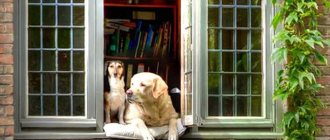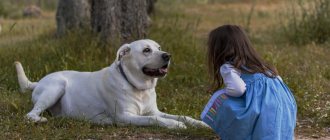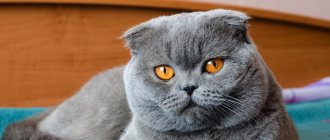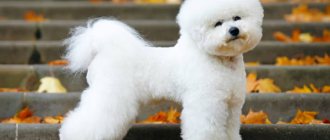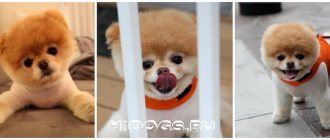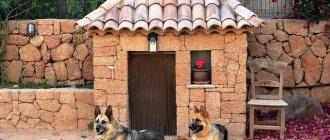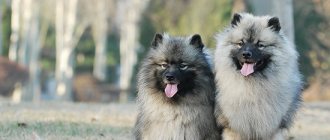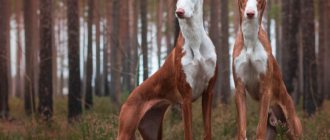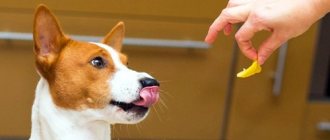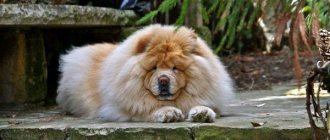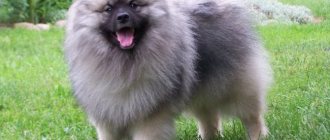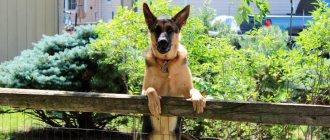The Bolognese or Italian lapdog is a small decorative dog. She is very charming, looks like a plush toy. These dogs are cheerful, sociable, friendly and affectionate. They can become a devoted companion for any owner. Suitable for adults and children, for the elderly, ideal for apartment living. But before you get an Italian lapdog, you need to study the description of the breed and care features. Reviews from the owners will help you learn about the pros and cons of the content.
- Head
- Upbringing
- Grooming
History of the breed
Unfortunately, there is no reliable information about Bolognese’s ancestors. It is believed that he was a type of Bichon that was crossed with Miniature Poodles. From them the new breed inherited a thick and more wavy coat. The name for the dogs was a place in Italy - Bologna. It was there that the first “outbreak” of popularity for small decorative pets occurred.
However, Italian Bolognese served not only as a companion to noble ladies. He was often involved in real service: sailors willingly took Bolonok with them on long voyages. On board the ship, dogs exterminated rats and other small rodents. There they brightened up the gray everyday life of sailors.
In those days, wherever people lived, there were hordes of rats, which caused significant damage. Such breeds, capable of solving this problem like the Prague Rater, were greatly valued.
Bologneses of the mid-20th century
The fact that the breed was in great demand is evidenced by numerous frescoes and paintings depicting the Bolognese. They were painted by such artists as Titian[, the inimitable Goya and the great master Bruegel the Elder. In addition, the breed was the most valuable gift for a nobleman of any rank.
One of the Italian aristocrats, Cosimo de' Medici, presented 8 Bologneses as a gift to the Brussels nobility. And the Spanish king Philip II even thanked his donor in writing for two Italian lapdogs.
The peak of Bolognese popularity occurred in the 12th-17th centuries. Towards the beginning of the 18th century, fashion changed dramatically and no one needed small dogs. This led to a significant reduction in the number of Bolognese Bichons, leading to the threat of their extinction. Fortunately, they lived to see the moment when a new wave of demand for miniature pets began, but among ordinary residents of Italy.
In the 18th century, Bolognese came to Russia for the first time and immediately attracted the attention of the aristocracy. Since the pet was presented to Catherine II by the French ambassador, the Russian-speaking population adopted the erroneous name “French Lapdog” for the breed.
For your information! French and Italian lapdogs are 2 different breeds. The first type is Bichon Frize, the second is Bolognese.
During the same period, the first selective work with the breed began. Breeders bred dogs exclusively as gundogs, not focusing on working qualities. However, the official recognition of the Italian Lapdogs was only in 1955 (according to other sources, in 1956). From that time on, they received access to world exhibitions.
Brief historical background
The first documented evidence of Bolognese dates back to the 11th-12th centuries . According to some reports, they were the result of crossing a Maltese (Maltese Bichon), considered one of the oldest dog breeds, and a dwarf poodle. Descriptions and images of small dogs of a similar type can be found in manuscripts of the 5th-6th centuries BC. It is assumed that this is a Maltese Bichon, but the order of origin of the breeds has not yet been established for certain. The Italian lapdog got its name from the city of Bologna, where it first appeared and from where it spread to other countries.
Bolognese is believed to originate from Italy.
The Italian lap dog was most popular in the period from the 12th to the 17th centuries. Most often, these small dogs were kept in noble aristocratic families. Then other small dogs came into fashion, and the number of Bologneses decreased greatly. In the 23rd century, funny furry animals began to be exported en masse to other European countries (Spain, France, the Netherlands, etc.). Around the same time, they came to the Russian Empire, where they were brought by merchants. Mentions of spoiled lap dogs with bad temperaments are often found in classical literature.
During the Renaissance, many artists and even such a great master of painting as Titian depicted Italian bichons in their canvases.
Renaissance painters often depicted small white dogs in their paintings.
Various political events (the French and October revolutions, the First World War, etc.) contributed to the almost complete disappearance of the breed. By the beginning of the 20th century, the number of remaining Bolognese Bichons could be counted on one hand. The population was restored solely thanks to the joint efforts of Belgian and French amateur breeders. Bolognese received worldwide recognition and official registration in the middle of the last century (1955) . The current breed standard was approved on November 13, 2015. The Italian lapdog is included in the FCI register in group 9 - companions and decorative dogs (section 1 - bichons and related breeds) under number 196.
Description
The Bolognese Bichon is a small dog that has a thick and white “fur coat”. Its coat is the main advantage of the breed. But at the same time, Bolonki are very stocky and strong, remaining compact “indoor” pets.
Classification
According to the Russian Canine Federation, the Bolognese belongs to section 1.1 - Bichons and related breeds. The closest “relatives” of the Italian Lapdog are: Maltese (Italy), Havanese (Cuba) and Bichon Frize (France).
Average weight, height and life expectancy
The height of male dogs at the withers is slightly higher than that of the opposite sex, and is 27-30 cm. For females, the parameters are as follows: 25-28 cm. Average weight is 2.5-4 kg. On average, Bolognese live quite a long time - more than 10 years and live up to 13-15 years. These parameters are similar to a breed such as the Bedlington Terrier.
Head
The head is of medium length, the muzzle is not elongated. The cranial part is ovoid (oval) in shape, with curved lateral surfaces. In length it does not exceed the length of the muzzle, which is 2/5 of the head. The frontal bones and occipital protuberance are well defined. The combination of the above factors visually gives the dog a square muzzle.
The nose is in line with the back of the muzzle. It should be large; among the pigments, only rich black color is allowed. Bologneses have normally developed jaws, with white teeth. The bite is correct (scissor), but a straight type is also possible.
The eyes are round and large. Should not be convex or set too deep. The iris covers the entire eye so that the white of the eye is completely invisible. The eyes have black contours, the iris can only be brown (dark ocher). The ears are hanging and long. Set high. Their base is quite dense, the upper part of the ear does not touch the skull. This makes the head appear larger than it actually is.
Young representative of the breed
Neck and body
The length of the neck is the same as the length of the head. The body is square, the length from the shoulder blades to the ischial angle is equal to the height of the Bolognese Bichon at the withers. The back is straight, but with a slightly arched and strong loin.
From there it smoothly transitions into the croup. The withers are hardly noticeable. The chest is voluminous, reaching the dog’s elbow joints. The depth of the chest is almost equal to the height at the withers. The belly is slightly tucked in.
Tail and limbs
The tail should be in line with the croup, thrown over the back. The forelimbs are straight and parallel. Paws are oval shaped. The pads are dense, the claws are only black. The feet on the hind legs are less oval. Bolognese's movements are free, his gait is energetic.
Coat, colors
The Italian Lapdog is a long-haired breed. Long hairs grow absolutely all over the body, starting from the head to the tail. The exception is the muzzle, where the hair is noticeably shorter. The coat is thick and fluffy. Thanks to this structure, it does not adhere to the body, but, on the contrary, is collected in “bundles”.
The standard defines only one type of color - pure white. However, having a faint ivory tint is not a gross fault and does not entail serious penalties in the ring. Other color options are not allowed.
How to brush your dog’s teeth at home and what products, besides a toothbrush and toothpaste, are needed for this
Flaws
Disadvantages are any deviations (even of a minor nature) from the registered exterior of the Bolognese breed. Defects include strabismus (or strabismus). Significant disadvantages include:
- lack of parallelism in the limbs;
- nose with a hump (Roman);
- serious discrepancies with the indicated height at the withers - too small or large individuals.
Appearance
Bolognese dogs have thick, beautiful fur of a uniform white color or white with fawn on the ears. A small cute face that always expresses fun, large intelligent eyes and a proud posture - it’s not surprising why many people like these dogs so much. And black eyes, lips and eyelids give Bolognese a very impressive look.
The average height of dogs of this breed is approximately 25-30 cm, and weight is from 2.5 to 4.5 kg. Their small body is covered with silky thick hair that curls in loose curls. You can get great aesthetic pleasure from such a dog by providing it with proper care. After a careful haircut and thorough combing, Bolognese Bichons closely resemble a powder puff.
Disqualifying faults
Defects are those shortcomings, the presence of which precludes the dog from performing in the ring. Italian Lapdogs are subject to disqualification in several cases. Individuals with behavioral deviations are not admitted. Simply put, if a participant exhibits aggression or severe cowardice (anxiety), he will be immediately disqualified. An unacceptable nose color (or partly pigmented) is also grounds for rejecting the dog's performance.
Those representatives of the breed who have an overbite or a shortened tail (naturally or due to docking) are not allowed to participate in exhibitions. Any color other than white, as well as the presence of spots on the coat, is a disqualifying fault.
If your pet has a pedigree and all the necessary documents, you can take part in special dog shows. To do this, check out the exhibition schedule for 2021.
Exhibitions with CAC rank awards for 2022.
Small lion dog (levchen)
It got its name because of the traditional haircut, which makes the dog look like a small lion with a lush mane. Before King Charles Spaniels and Lewchen Pugs came into fashion, they were common among high-ranking ladies. Artists have painted these dogs on their canvases since the 14th century. By the beginning of the 20th century, the lion dog lost its relevance and was absorbed by other types of lapdogs, turning it into street dogs for plebeians.
After World War II, the breed was revived, but remained so rare that in 1960 it was listed in the Guinness Book of Records.
The breed standard was established in 1961. The dog's height is 26-32 cm, weight is about 6 kg
The shape of the head is important, influencing the contours of the dog like a lion. The coat is long, wavy (but not curly and should not hide the silhouette), can be of any color (except for all shades of brown), the most valuable are black, white and fawn colored levchens.
The ears are drooping and covered with hair, the muzzle is short, the eyes are dark and large, the head is wide in the skull. The tail only slightly touches the back with the tip, is set relatively low and is a semicircle. The most important thing is that the levchen looks like a miniature lion.
Like all lap dogs, the lion dog has a cheerful disposition and excellent obedience. She will be affectionate with her owner and his family members; she is always happy to be present in all areas of a person’s life. The Levkhenovs are distinguished by their courage and intelligent, attentive gaze.
Interesting photo
Dog on a walk
Bolognese listens attentively to his owner
Very well trained Just a beautiful photo of the dog
Bolognese puppy
Bichon Frize breed standard
Decorative Bichons have a slightly elongated head proportional to the body. It appears round because of the cloud of fur.
The eyes are large, round in shape, black or brown. There are dark spots around the eyes. The muzzle is short and strong, the lower lip is completely covered by the upper.
According to the basic standard, the bite is scissor-shaped, but a straight bite is also allowed. The dogs have a black, round nose. The ears are drooping and covered with fur. According to the standard, the ears should reach the level of the lips.
The body of small pets is rectangular, the back is wide and straight, the chest is deep and well developed. The thin and high neck makes up a third of the length of the body. Bichons are distinguished by strong, muscular limbs with black claws.
Their tail is of medium length, covered with hair, located below the level of the back, and is not docked. With positive emotions, dogs raise their tail and hold it parallel to the spine, without touching the back.
The most common disadvantages of French lap dogs include:
- Black or red spots on the coat.
- Short or straight coat.
- Malocclusion.
For show-class dogs, disqualifying defects are:
- Pink nose.
- Tail twisted into a spiral.
- Light colored iris.
- Cryptorchidism.
- Cowardly or overly aggressive character.
Size and weight
The low weight and dwarf size of the Bichon Frize dog are compensated by its strong build. Decorative dogs reach 30 cm at the withers, and their weight reaches only 5 – 6 kg.
Color and coat type
The Bichon lapdog is covered with curly and soft hair, the length of which can reach 10 cm. Underneath it, the dog has a dense and dense undercoat, thanks to which the animal does not get wet in the rain. After water treatments, the fur increases in volume, which is why the dog looks like a dandelion or a fluffy cloud.
For an adult dog, the standard allows only one color - snow-white. Puppies may have a beige or yellowish coat that fades over time. According to the standard, a puppy's area of yellow or beige fur should not occupy more than 10% of the surface of its body.
Character and temperament
The Bolognese is a compact lap dog, which since ancient times had only one purpose - to be a companion for people. This means that representatives of this breed are distinguished by their good-natured disposition and affectionate character. They are quite people-oriented.
Bolognese Bichons are very loyal and affectionate. A pet may even become depressed from a long separation. Lack of attention and communication also does not benefit them. Due to its positive temperament, it is a suitable breed for children aged 8-10 years. However, Bologneses are very sensitive and will not tolerate cruel treatment. Therefore, young children should be explained in advance how to behave with a miniature lap dog.
But despite so many positive qualities, the dog will only feel comfortable surrounded by its family and loved ones. They are distrustful of strangers. Lack of proper socialization only increases coldness towards others. In addition, Bolognese can become aggressive and anxious.
With good upbringing, the Bolognese Bichon is a balanced and friendly pet, ready to accompany its owner everywhere. However, you should not expect security skills from the dog - this is a decorative breed and it will not be able to protect the family. But the brave pet will always inform those around him about the visit of “uninvited” guests.
You should not choose a breed as a hunter. Yes, Bolonki were used to catch small rodents, but those days are long gone. Most dogs were decorative and accompanied their owners.
Considering that Bologneses do not have working instincts, they can exist quite peacefully with other animals, including cats and rodents. Some individuals experience jealousy and at such moments are capable of malice. In general, Bolognese Bichons are not prone to aggression and prefer to lead a peaceful life, avoiding conflict situations in every possible way.
Patiently waiting for their ring at the exhibition
Nurseries
Bolognese or Italian lapdog are decorative show dogs. It is best to purchase them from nurseries. In such places, future owners will receive documents confirming the origin of the breed and will not overpay.
Nurseries:
- “Snow Watch”, Sosnovy Bor (Leningrad region), website bobtail-dozor.ru (price - from $550);
- “Elkates Show”, Moscow, malteseclub.ru
- “Bi Natal”, binatal-chenki.jimdo.com. (price - from 350 dollars).
The Bolognese is a beautiful toy dog with a friendly disposition and playful character. Small pets are rarely aggressive. If not raised properly, they can behave capriciously, demanding that their owner fulfill their whims. Usually the Bolognese is a sweet companion who is devoted to a person until death.
Dog care
The owner of an Italian Lapdog will have to regularly devote time to grooming his pet. Long hair needs constant attention and must be brushed daily, sometimes several times a day. However, if the owner prefers to give his dog haircuts, caring for him is greatly simplified.
Haircuts are best left to a professional. They are carried out as the fur grows. As a rule, groomers shorten the coat, creating clearer body contours for the pet. The wishes of the owner are also taken into account. Additionally, a hygienic haircut is carried out - the dog’s paw pads and groin area are shaved.
At the same time, caring for the Bolognese's coat is quite possible at home. To do this you will need some tools. First of all, these are various brushes, scissors, a furminator, and possibly a tangle cutter.
Bathing procedures are an important part of caring for Bolognese. It is recommended to wash it 1-2 times a month. Since the coat tends to get dirty and tangled, it is highly advisable to purchase dog shampoo (whitening is possible) and conditioner. It is necessary to rinse each strand to avoid tangles.
Warning! Show Bologneses are not cut. They are carefully combed with combs and washed. Visually, the dog should be well-groomed and have a natural coat shape.
From time to time, you will most likely have to trim your dog’s nails, since long walks are not expected, which means they will not naturally wear down on a flat surface. This is a simple procedure and can be done at home. To do this you will need a nail clipper and a special file.
Communication with people
Bolognese have been destined to become household pets since the ancient times of the Roman Empire. These animals are unusually affectionate and loyal. They constantly cuddle up to their owner and experience great nervous stress if they are separated from him. The Italian lap dog is perfect as a friend for older people.
Being small in size, the dog can live indoors with its owners and not cause them much trouble. It should be borne in mind that these living creatures are quite fragile and can be damaged if handled carelessly or too harshly. For this reason, it is best not to have a Bolognese as a pet for a young child.
The dog will not be able to stand up for itself and cause any harm to the human baby, but it can receive serious injuries from it due to carelessness. It is better to give a puppy of this breed to a child who has already reached the age of eight years or older, who will take care of his pet and be quite careful and careful when playing with her.
The Bolognese is not suitable for those people who are looking for a guard dog for their home. They are not aggressive and are too small to be able to withstand an attack from an adult. But at the same time, one more character trait should be noted that is associated with her social adaptation. Being attached to their owners to the point of selflessness and deep devotion, Italian lapdogs do not like strangers.
If the dog is regularly walked in crowded places, it will adapt to the company of strangers and will perceive them, if not friendly, then at least without panic reactions. If the puppy grows up only surrounded by people she knows, then when a new and unfamiliar person appears, she may become aggressive or too shy, try to hide in a far corner and become invisible to the stranger.
The friendly nature also manifests itself towards other animals. They react calmly to cats. They can show aggression towards their own kind only in case of jealousy during the breeding season.
Italian lapdogs are easy to train. They were always taught to perform various tricks, which were then enjoyed among friends and at dinner parties. They are very sensitive to any manifestation of rudeness and intemperance on the part of their owners. If you yell not even at the dog itself, but simply in its presence, then the pet is guaranteed to have a nervous breakdown.
If you want to teach your pet various tricks, then it is better to treat him with gentleness and affection. This way the process will go faster and be more fruitful. In addition, lap dogs love praise and will try even harder for it. But don't forget about the small dog syndrome.
The owners of this sweetest creature forgive them everything that would not be worth forgiving, only for their fragility, tenderness and affection. In this way, the little pet comes to the point where he feels like a household master. You need to love and care, but you shouldn’t indulge and pamper.
Housekeeping and walking
Thanks to its small size, the Italian Lapdog will fit perfectly even into a small city apartment. But this does not mean that the pet will not be happy to live in a private house. The main criterion for such a pet is constant care and attention.
Bolognese does not require large amounts of physical activity. A short walk of 30-40 minutes is enough for them. On average, you can devote from 1 to 2 hours a day for walking.
How often do you need to care for your dog’s ears, and what lotions, drops and other products are used at home?
Conditions for keeping
Care and haircut
When it comes to care, Italian lap dogs are not particularly demanding; in general, puppies can adapt to any living conditions. Since this breed is quite easy to care for, these dogs are often owned by older people. Standard grooming is not a problem, because the dog can always be “dumbed down” using a machine.
The puppy should be taught from an early age that you will constantly brush its fur. As mentioned above, long and thick fur is one of the characteristics of the animal, so first of all you need to take care of it. Since the hair itself has a fine structure, it quickly becomes tangled, but with regular combing this can easily be prevented. For this, special metal combs with rounded teeth are used.
It is necessary to comb a dog of this breed carefully so as not to pull out the hair with roots and not cause pain to the pet. If tangles do form on the fur, experts recommend applying balm and after a couple of minutes try combing the area again. Lapdogs are very sensitive to unsanitary conditions - if kept this way, the dog will often get sick. Moreover, the vegetation on the dog’s body suffers from dirt and dust.
Although Bologneses have long fur, they do not shed as noticeably as other dog breeds with thick hair. This is because lap dogs have no undercoat. The dog should be bathed twice a month, and the animal should be groomed once every four weeks. For bathing, you should purchase a special product for long-haired individuals. If you don’t want to bathe your pets, then from time to time you can use dry shampoos, which you can buy at any pet store.
Since lapdogs also have a lot of fur on their faces, this can cause problems. When hair falls out, it can irritate the mucous membranes and get into the eyes, so the breeder needs to wipe the dog’s eyes daily. For this purpose, special eye products are used, which are applied to napkins or cotton swabs.
Discharge must be removed carefully so as not to harm the dog.
A similar situation exists with the ears. They should be carefully cleaned, removing hair and dirt. Nails need to be trimmed from time to time. In general, in terms of care, everything is quite simple. The breeder is only required to do everything carefully and in a timely manner.
Optimal diet
An important point is the preparation of the diet. Lapdogs, like many other small breeds, are prone to overeating and generally eat a lot. In order for an animal’s body to always be in good shape, it must receive proteins, carbohydrates, calcium and fats. And puppies need phosphorus in childhood, as it has a positive effect on brain activity and muscle contractions.
Preparing a high-quality diet for your pet is not an easy task. According to experienced dog breeders, Bolognese dogs should eat high-quality ready-made food or canned food. At the same time, the meat content in them should be increased. Once a week, your dog can be given fruits and vegetables processed with boiling water, but only in small quantities.
To improve the condition of body hair, you should regularly add vitamins and various supplements designed for this to your diet. But it’s better to consult a veterinarian in advance. If there is food, then it should always be of high quality; using cheap food can only harm the health of the pet (video author - Max Ivanov).
Owners of lap dogs often refuse food for various reasons. This may be the inability to find quality food in the city or a food allergy. By the way, allergies usually also manifest themselves to low-quality food, so keep this in mind.
If you decide to feed your dog natural food, you should include in the diet:
- beef meat, the leanest, sometimes chicken is allowed;
- porridge - oatmeal, buckwheat or rice;
- vegetables and fruits (occasionally);
- Once a week you can give a raw quail egg.
To avoid an allergic reaction, you need to give your dog only fresh food. Any smoked products must be excluded, the same goes for confectionery and sweets. It is also better not to overdo it with bones, but in principle to abandon them, especially tubular ones.
Training and education
Being people-oriented, Italian Lapdogs are highly trainable. They are able to learn even non-standard tricks along with the basic set of commands. Some Bologneses achieve success in the field of sports. You can perform with them on obedience (international standard of obedience).
Lack of upbringing or mistakes made lead to the appearance of “small dog syndrome” in the Bolognese Bichon. This syndrome is characterized by increased aggression, agitation and nervousness of the pet. It arises not only from lack of training. Poor socialization, constant confinement within four walls (lack of walking) have an extremely negative impact on the dog’s condition. Therefore, it is undesirable to completely deprive your pet of being in the fresh air and limit communication with his own kind.
It will be necessary to purchase special equipment for walking
Where to buy and price
This breed is not very common in Russia; it is not easy to buy purebred Bolognese puppies. You can bring a pet from Europe, where there are breeding nurseries for this breed. You should not trust dubious sellers who do not provide a pedigree and other documents for the dog; the risk of purchasing a mongrel or mixed breed for a lot of money is too great. The price for a baby Bolognese Bichon ranges from 25,000-60,000 rubles. The price is affected by the class of the dog.
Italian lapdogs have a wonderful character, they are smart and cheerful. By taking a pet of this breed into the family, the owners acquire a faithful friend and companion for their children.
Advantages and disadvantages
The main advantages of the breed include its compact size and positive character traits. Bologneses can be an ideal option for an inexperienced person, as they are easy to train. They do not need a large amount of physical activity and live quietly in urban environments.
Bolognese Bichons are wonderful dogs for families with small children. They are very playful, love toys and love to be the center of attention. Lapdogs are also suitable for all those who like to follow fashion. The glamorous pet will always attract the admiring glances of passers-by.
Disadvantages include difficult pet care. If a potential owner values cleanliness or does not want to mess with the dog’s fur, it is better to immediately abandon the Bolognese. The breed is also not suitable for those who may be away from home often and for long periods of time.
Pros and cons of the breed
The table below shows the advantages of the breed and the difficulties that the owner of the animal may encounter:
| + | – |
| A miniature dog that feels good in a city apartment | Cannot stand loneliness, strong attachment to a person |
| Good health | |
| Friendly nature and easy to train |
Feeding
Bolognese is quite unpretentious in food, but the diet must be balanced. Particular attention is paid to vitamins and minerals - it is recommended to add special nutritional supplements to the food if the owner prefers to cook himself. It is very important that the diet contains vitamin A, which has a beneficial effect on the dog’s vision.
The main menu can consist of natural products (where 50% of all food is meat) or prepared products. It is extremely undesirable to implement the idea of mixed feeding - this will cause a blow to the pet’s digestive organs.
If you choose to feed on a natural basis, then it is advisable to give your pet boiled sea fish without bones 2-3 times a week. Meat can be periodically replaced with offal. Additionally, raw vegetables are added, which must first be finely grated. Fruits in moderation.
Carefully! Bolognese should absolutely not be offered sweet foods, as well as any types of bones.
In addition, you need to seriously consider the choice of food bowl, stand and rug. Since all Bologneses have long and voluminous hair, care must be taken to ensure that it does not get dirty during feeding. Small, metal bowls and a simple rubber mat will do. Since the dog is small, a low stand is suitable or you can do without it altogether.
An even better option would be to purchase an automatic dog feeder. It will ensure accurate rationing of feed and its delivery strictly at the programmed time. In addition, it would be useful to purchase a drinking machine. In this case, the dog will have round-the-clock access to clean, filtered water.
Don't forget, these tips are only suitable for adult dogs; puppies have their own feeding principles and rules.
Also, if the dog is old, its diet also needs to be reviewed. Read about this in a special article.
Diseases and life expectancy
In general, the Italian lapdog is characterized by good health and, with good care, will live 15-17 years. You should pay attention to the weight of the animal, avoiding obesity. Your dog's teeth require regular care. Bolonki are prone to the formation of tartar. Once a week, the pet’s oral cavity is cleaned with a special product, and the animal is periodically allowed to chew on an apple, a pear, or a special dog treat made from the veins.
Health
Bologneses are susceptible to eye diseases. They need to be monitored regularly and washed if necessary. But in general, the breed does not have serious genetic and hereditary diseases. These are healthy dogs that can live to a very advanced age. But at the same time, lap dogs have quite sensitive skin. They are prone to various allergies, so all new foods are given with great care. For coat care, purchase only special dog shampoo to avoid skin irritation.
A bitch who gave birth with her puppies
What diseases is the breed susceptible to?
The average life expectancy of Italian lap dogs is 13-15 years. Bichons are considered fairly healthy dogs, but they are also susceptible to developing some diseases.
- Eye diseases (improper eyelash growth, inflammation of the cornea, cataracts). If you notice increased tearing, irritation of the skin around the eyes, clouding of the mucous membranes, smudges, you should take your dog to the veterinarian
- Diseases of the hearing organs. The inner surface of the ears should be light pink, without an unpleasant odor or excessive wax formation. If the dog scratches its ears, shakes its head, or has discharge, it is better to take your pet to the doctor.
- Dental diseases - to prevent and treat oral diseases, you should take your dog to a veterinarian-dentist once every six months for cleaning and treatment if necessary.
- Allergic and skin diseases
- Limb subluxations
If the dog has become less active, has lost its appetite and its behavior has changed, do not look for the cause on your own, contact a veterinary clinic. Timely and correct treatment will prolong the happy life of your pet.
Mating, pregnancy, childbirth
Bitches come into heat 2 times a year. Mating should take place during the estrus phase (heat), when conception is more likely to occur. If mating was carried out during the proestrus phase (pre-estrus), there is a high risk that fertilization will not occur. Moreover, such mating significantly increases the risk of false pregnancy in a bitch.
Pregnancy in Bologneses proceeds in the same way as in other breeds. It lasts 58-65 days. At this time, the pet needs to be walked and fed 3-4 times a day. If the dog owner has never delivered a dog before, it is advisable to invite an experienced veterinarian. Without proper preparation, the owner can introduce dangerous infections into the dog’s genitals.
In the case of numerous offspring, the mother dog’s milk may not be enough for all the puppies. In this case, it is necessary to supplement them with a special substitute for bitch milk.
Varieties
Today, several breed subgroups have been identified, which include lapdogs with similar appearance and characteristics. They differ in the place of breeding and growth.
You can get acquainted with the varieties of Bichons in the table below.
Breed diversity
| Breed name | Short description | Peculiarity |
| Havanese (Havanese Bichon) | They have a lush coat, which can be either white or have various shades of brown, spotting is allowed. Representatives of the breed get along well with children and pets. | Highly people-oriented. If a dog is left alone for a long time, it will find entertainment in the form of damaging furniture, carpets, etc. Havanese is considered a rare breed in the Russian Federation |
| Bolognese dogs (Bolognese) | The short fur on the face becomes longer on the rest of the body. The dogs have a square-shaped body, unlike other Bichons. | The dog's complete inability to remain alone for more than a few hours. If the owner of the Bolognese leaves the house for a long time, then the neighbors will have to listen to the dog’s very loud protests expressed by barking or howling. |
| Maltese dogs (Maltese) | Belong to the decorative group. The coat is long and requires careful care from humans. Despite the lack of watchdog qualities, the Maltese will easily bark at a stranger, and may even bite him. | The lack of undercoat makes representatives of the breed desirable pets in the home of people with allergies. It is especially worth noting that Maltese dogs have diseases that are inherited. Just like other Bichons, they cannot stand being alone. |
| Levchens (lion dogs) | They are also lap dogs and have a friendly and affectionate character. Do not show aggression towards other pets | There are no genetic diseases. There is no shedding process as such in dogs. Taking care of the pet’s coat will take up quite a lot of the owner’s time, and periodic visits to the groomer are not a cheap pleasure |
| Coton de Tulear (Madagascar Bichon) | They are similar to Havanese, and breeding work on natives from Madagascar has not been completed to date | Ideal pets for families. The dogs are very attentive, playful, and vigilant. Perfectly adaptable both in an apartment and in a country house. Cotons require intensive socialization and appropriate training to avoid behavior problems. |
| Russian colored lapdogs | For this breed, the standard provides for any colors, with the exception of snow-white. The dog is very intelligent and clearly captures the mood of the owner | Activity and endurance allow the lapdog to take long walks with the owner. Thanks to its good adaptability to transportation, the dog will be able to go with a person on any trip. |
Search for a puppy
Italian Bolonki are moderately popular in Russia. They are not rare, but finding a puppy can be a little tricky. The problem is that there are practically no single-breed breeders of this breed left in Russia. Most often they are found in a few multi-breed nurseries and at a reasonable cost. The average price for Bolognese puppies is about 18-25 thousand rubles. You can find a suitable pet in large cities (Moscow, St. Petersburg), as well as in the Moscow and Leningrad regions.
How to buy a Bolognese Bichon puppy
You can only purchase a purebred lapdog from a nursery or from a responsible breeder. Before purchasing, it is recommended to study the living conditions of the animals, meet the mother, and communicate with the owner. It is important that you have all the necessary documents and veterinary certificates.
In Moscow, a purebred puppy can be bought for 30-40 thousand rubles. The offspring of exhibition winners are more expensive, the price for them reaches 70-80 thousand rubles. It is not recommended to buy a dog secondhand or at the market; there is a risk that it will be sick or not purebred.
When choosing a puppy, you need to pay attention to its color so that there are no dark spots. The paws should be straight, the gait should be confident, the nose should be black. A healthy puppy has no discharge from the ears and eyes, hair without dandruff and bald spots. The nose is wet, there is no unpleasant smell. And the behavior is active, playful.
Photos of Bolognese puppies:
The video complements the characteristics of the Bolognese dog breed:
Video: Italian lapdog (Bolognese, Bolognese bichon) - all about the breed through the eyes of the owner
The Italian lapdog is a decorative miniature dog. Thanks to her cheerful, outgoing nature, she can become the best friend of both a child and any adult. This dog will not only decorate the house with its attractive appearance, but will also make life more fun and will not let you get bored.
Interesting Facts
Clipped Bologneses resemble a white powder puff. This is exactly how dogs were characterized in France in the 18th century.
It is generally accepted that Italian Lapdogs are very fond of cosmetic procedures. Perhaps this affection arose due to the fact that dogs were carefully looked after since the times of Ancient Rome.
According to some reports, dog handlers and enthusiasts managed to restore the breed's numbers when there were only nine Bologneses in the world.
Until now in Russia, Italian lapdogs are mistakenly called French.
Origin
Italian dog owners obtained the Bolognese breed by crossing lapdogs from the island of Malta with poodles of the dwarf variety. It was from the poodle that the Bolognese Bichon received its wavy, thick coat. Representatives of the breed were happily introduced into wealthy homes in Italy. It was fashionable and spoke of the high social status of the owner.
In the 16th century, Italian lap dogs found their way to France, where they quickly became popular. It is known that the Marquise de Pompadour, influential at the royal court, was a great lover of these dogs. Two centuries later, several Italian lap dogs were presented as a gift to Catherine II. Since they were given by the French ambassador, the dogs in Russia are also called French lapdogs. Italian lapdogs are still popular today. Small, cheerful and friendly dogs have charm and leave no one indifferent.
Reviews
On the Internet you can find positive reviews from enthusiastic owners of a white lap dog. First of all, the owners note their extraordinary intelligence and penchant for learning. At the same time, the fact that you will have to spend a lot of time on your pet stands out, since without caring for the coat, the Bolognese Bichon quickly becomes overgrown with tangles.
However, some owners did not receive positive impressions from this breed. In particular, they complain of an uncontrollable character, distrust of family members and bad habits (for example, relieving themselves at home). Attempts to rehabilitate the pet did not lead to success.
How did the lapdog dog breed originate?
The very first lapdog is the Maltese, whose name arose as a result of a geographical error. In fact, the homeland of this dog is not Malta at all, but the island of Melida, or Mljet, located in the Adriatic Sea near Croatia.
Due to the antiquity of the breed, there is no reliable data on its entry into the Adriatic. Scientists are inclined towards 2 theories:
- Penetration via the Silk Road, subject to close relationship with Tibetan terriers.
- The animal was brought from Switzerland, and its ancestors are local Spitz-like animals.
Four-legged animals quickly gained popularity among members of the aristocracy, but commoners did not like them because of their poorly developed working qualities. The breed appeared in Russia thanks to the French troops, who abandoned their pets at the time of Napoleon’s retreat. When crossed with aboriginal dogs, another type of lapdog appeared - the Russian.
The name of the breed, familiar to many, comes from the Italian city of Bologna. Despite this, in the FCI classification, a group of these dogs is called bichons from the French. bichonner - “to pamper”, “to preen”.
